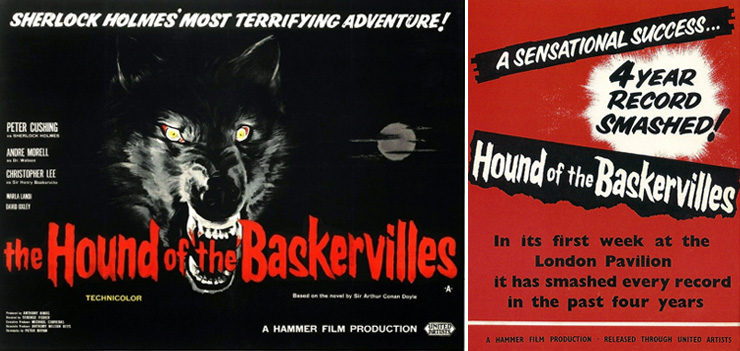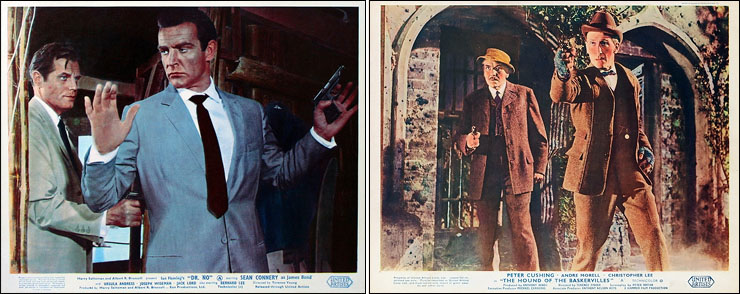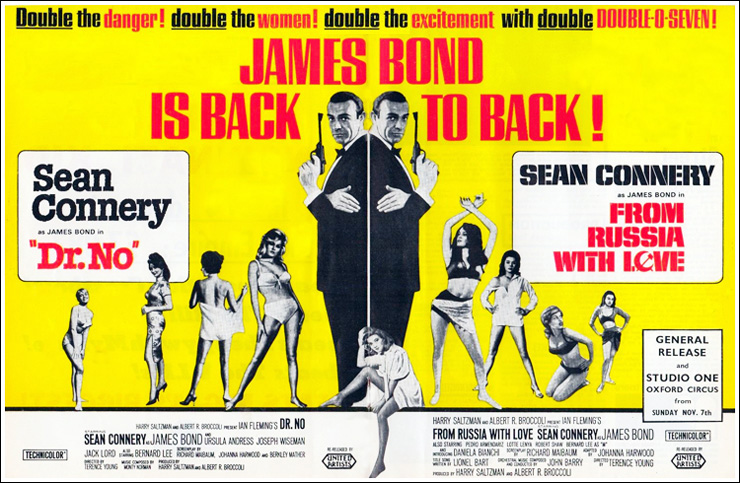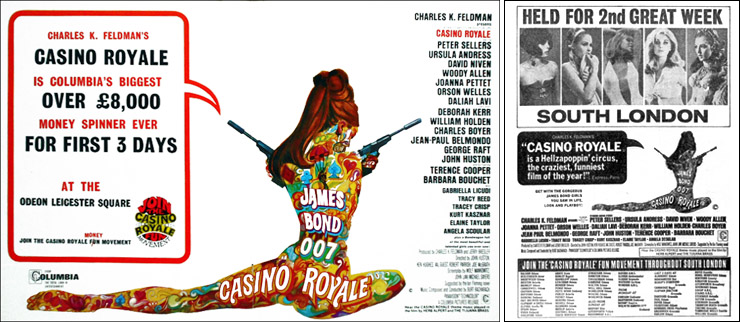EXCLUSIVE ARTICLE |
||
|
||
EXCLUSIVE ARTICLE |
||
|
||
 |
|
Dr. No was revived again at many cinemas just before and during the general release of From Russia With Love (1963), paired with a variety of second features, from Westerns, to crime dramas and even comedies. However, it was a 1964 pairing with the 1959 Hammer Films adaptation of The Hound Of The Baskervilles that re-introduced Dr. No to many fans. This was the first time in the UK that Dr. No had been paired with another high-profile film, rather than a B-film second feature. |
 |
|
Originally released at the height of Hammer Films’ success in 1959 following the spectacular box-office hits The Curse Of Frankenstein (1957) and Dracula (1958), both starring Peter Cushing and Christopher Lee, The Hound Of The Baskervilles was another property suitable for bringing to the big screen as part of the horror revival initiated by the studio in 1957. As an independent producer, Hammer Films looked to American studios to fund and distribute their product, and formed successful relationships with most of the US majors during this period, enjoying profitable partnerships with Warner Bros, Universal, Columbia and Paramount. Hammer's first significant commercial horror hit had been their 1955 adaptation of Nigel Kneale's 1953 BBC Television science fiction serial The Quatermass Experiment, directed by Val Guest. The title was changed to The Quatermass Xperiment in the UK to exploit the ‘X’ certificate introduced by the British Board of Film Censors in 1951. Films classified as extremely graphic were passed for public exhibition where no children under 16 were present. The film was unexpectedly popular and led to a 1957 sequel Quatermass 2. Both films were distributed by United Artists in the USA, and had their titles changed to The Creeping Unknown and Enemy From Space, as the name ‘Quatermass’ had no recognition in America as the TV series was not broadcast overseas. Following their back-to-back hits returning Frankenstein and Dracula to their Gothic roots, Hammer chose to film The Hound Of The Baskervilles (the first Sherlock Holmes film in colour), but despite its lurid advertising and horrific story elements, was only awarded an ‘A’ certificate by the BBFC, meaning the film was passed for public exhibition, but patrons under the age of 12 must be accompanied by an adult. |
||||||
 |
||||||
|
Despite Hammer being dismayed by the lenient certification, it opened up a larger audience for the film which went on to break the box-office record (then held by the 1954 Burt Lancaster/Gary Cooper Western Vera Cruz) at the London Pavilion in its first week in March 1959. The Hound Of The Baskervilles played for a month at United Artists’ flagship London Pavilion [pictured below] (as had the two Hammer Quatermass films), and then went on general release across the UK. Although a record-breaking hit in London, The Hound Of The Baskervilles did not replicate its box-office success upon general release in June/July 1959. |
||||||
 |
||||||
|
||||||
|
||||||
 |
||||||
|
It is perhaps then less of a surprise that The Hound Of The Baskervilles found itself as the supporting feature to Dr. No in many provincial cinemas throughout 1964. The fact it was distributed by United Artists and had an ‘A’ certificate meant it could play without restrictions on the audience, as would be the case in the 1970s when James Bond films were paired with ‘X’ certificate Clint Eastwood Westerns. One must also remember that although The Hound Of The Baskervilles is now a well-respected classic of the genre, when first released, and as a supporting feature, it was essentially just another studio product available for distribution. |
||||||
|
||||||
|
The Hound Of The Baskervilles continued to support other United Artists releases throughout the 1960s, and also played with From Russia With Love and Goldfinger in 1965; and Thunderball in 1966/67. None of these programmes were considered as a double-bill as we now know the term, so no new posters or advertising material were created for the pairings. The Hound Of The Baskervilles was always the supporting feature to the James Bond film on these re-issues, so the programme would generally be promoted with earlier versions of newspaper advert blocks, and original or re-issue versions of the quad-crown posters. The Hound Of The Baskervilles later debuted on UK television in November 1969, and although never fully networked it played on most ITV channels well into the 1970s. |
||||||
 |
||||||
|
Although Thunderball would not go on general release until January of 1966, 1965 would prove to be the most successful year to date for James Bond across several different platforms. The sales of Ian Fleming's novels in paperback had steadily increased since the release of Dr. No in 1962. Overall sales had leapt from 1.3-million copies sold in the UK in 1962, to a staggering 6.8-million by the end of 1965. The PAN paperbacks were reprinted many times throughout this period (including film tie-in editions of those three novels adapted for the screen), with sales no doubt boosted by Raymond Hawkey's innovative cover designs and the use of the word ‘James Bond’ above the title. |
||||||
|
||||||
|
Dr. No and From Russia With Love had both been re-released in cinemas whilst Goldfinger was still on general release across the UK, with many venues showing all three films on different days of the week in order to maximise profits. Many cinemas opted for a ‘James Bond week’ whereas the Essoldo Newcastle programmed a ‘James Bond Season’ starting with Dr. No [supported by Foreign Intrigue (1956)] on Sunday May 16th; followed by From Russia With Love [supported by Indian Fighter (1955)] from Sunday 23rd, and finishing with Goldfinger [supported by War Hunt (1962)] for one week commencing Sunday May 30, 1965. Clearly these films were still capable of attracting enough customers to fill the 2,200 seats, that the cinema could justify turning over three weeks of programming just to James Bond. At this point no two James Bond films had ever played on the same programme at any cinema in the UK. It was not until November 7, 1965 when Dr. No and From Russia With Love were issued as a double-bill that the tradition of re-releasing earlier films in the series ahead of the latest blockbuster was established. |
||||||
 |
||||||
|
||||||
|
Sean Connery's announcement in July 1966 that You Only Live Twice would be his last James Bond film signalled the demise of the Sixties spy craze. Although the search was on to find a new actor to play James Bond, there was no certainty this would come to fruition, and that audiences would accept anyone else in the role. Although On Her Majesty's Secret Service had been announced as the next film in the end credits of You Only Live Twice, it would appear at the time that United Artists were resigned to the fact that the James Bond series may have fulfilled its potential, and in June 1967 they offered the first five films in the series (and the then unmade On Her Majesty's Secret Service) to US TV stations for $30-million. The proposed deal would allow two films to be released each year over a three-year period; each film could be shown twice and after the deal expired the rights would revert to the owners. Although there was interest at this stage, the record-setting price of $5-million per film proved too expensive at that time. |
||||||
|
||||||
|
Although You Only Live Twice did not have its general release across the UK until September, it did play in many cinemas at South Coast resorts from Thursday June 29, 1967 in order to capitalize on the captive summer holidaymakers, who would have invariably have schoolchildren with them. This included a ten-week season at the Dreamland Amusement Park Complex in Margate. You Only Live Twice was booked for the whole summer season, with two one-week breaks where audiences could see pre-release screenings of two new Westerns currently playing in London's West End; El Dorado (1966) starring John Wayne, and The Professionals (1966) starring Burt Lancaster. United Artists later adopted this coastal distribution pattern for the summer release of Live And Let Die (1973), The Spy Who Loved Me (1977) and A View To A Kill (1985), all of which had a similar schedule before been widely shown across the country. |
||||||
 |
||||||
|
Despite the advertising campaign centred around the tagline “Sean Connery IS James Bond”, it was clear by the time You Only Live Twice went on general release in September 1967, public interest in 007 had begun to wane. By no means a box-office failure, You Only Live Twice came nowhere near to matching the record-breaking receipts of Goldfinger (1964) and Thunderball (1965). The presence of another James Bond film also no doubt affected the box-office takings for You Only Live Twice, which by later 1967 was just another outrageous spy film competing in the marketplace. Distributor United Artists erected a huge 48-sheet (120 X 240 inches) poster on the roundabout at the Elephant & Castle in Southwark, reminding cinemagoers that “Sean Connery IS James Bond” and You Only Live Twice was coming soon! |
||||||
 |
||||||
|
Released two months before the premiere of Sean Connery's then final appearance as 007, Casino Royale grossed £8,000 in its first three days at the ODEON Leicester Square, becoming the most successful Columbia film to play at the cinema up to that point. Casino Royale then went on simultaneous general release across the country. Boosted by its success in London's West End, many cinemas pre-booked the film for two weeks expecting the kind of box-office returns garnered by other James Bond films. This was not the case in the provinces and most cinemas later cancelled the second week. Perhaps many cinemagoers also took notice of the reviews and general bad press the film got at the time. Film critic John Russell Taylor summed things up in his review for The Times on April 14, 1967:
|
||||||
 |
||||||
|
Whatever audiences and critics thought of Casino Royale at the time, there was another James Bond parody released the following year that even spoofed its tag-line, by announcing that if Casino Royale was Too Much for one James Bond, Operation Kid Brother was Too Much for one Mother! |
||||||
 |
||||||
|
|
||||||